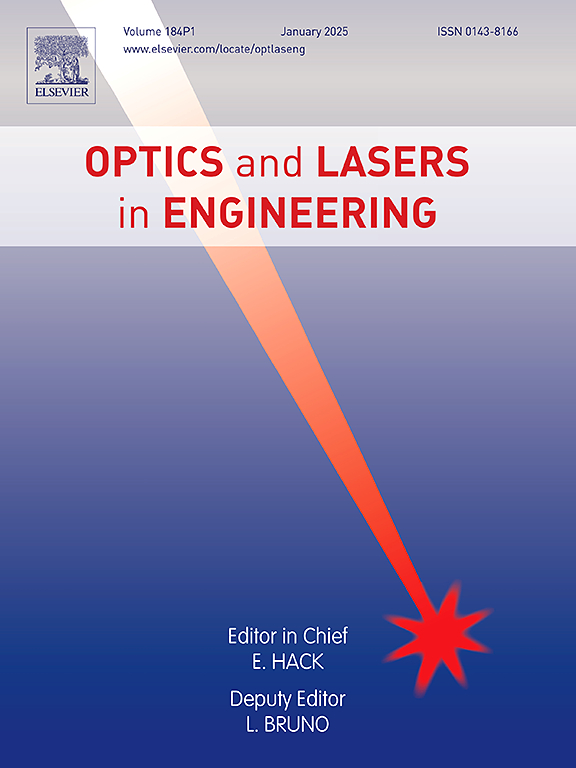Measurement of coherence-polarization matrix from a single-frame recording
IF 3.5
2区 工程技术
Q2 OPTICS
引用次数: 0
Abstract
Characterization of statistical properties of a vector source requires fast and efficient measurement of all four elements of the square coherence-polarization (BCP) matrix. Here, we report a new experimental technique for measuring the BCP matrix of the stochastic field using a single-intensity recording. A detailed theoretical framework is presented to measure the elements of the BCP matrix of vector source through polarization correlation of the first two Stokes parameters (SPs), S0 and S1. We validate our technique through numerical simulations followed by proof-of-principle experiments. Experimental demonstration is performed by employing a specially designed folded interferometer to coherently sum a vector random field with a known reference and subsequently leverage a tuneable beam displacer to capture the orthogonal polarization components to determine the first two SPs in a single-frame recording. A correlation of these two SPs and their Fourier processing enables the extraction of all four elements of the BCP matrix from a single-intensity recording. The viability of our experimental technique is demonstrated by measuring all four elements of the BCP matrix for three different vector sources in the far-field. A good agreement between simulation and experimental results confirms the accuracy of the proposed technique. This method will find applications in the characterization of light fields, evaluating the polarization dynamics, looking through randomness, etc.
通过单帧记录测量相干极化矩阵
要描述矢量源的统计特性,需要快速有效地测量方形相干偏振(BCP)矩阵的所有四个元素。在此,我们报告了一种利用单强度记录测量随机场 BCP 矩阵的新实验技术。我们提出了一个详细的理论框架,通过前两个斯托克斯参数(SP)S0 和 S1 的偏振相关性来测量矢量源 BCP 矩阵的元素。我们通过数值模拟验证了我们的技术,随后进行了原理验证实验。实验演示采用专门设计的折叠干涉仪,将矢量随机场与已知参考相干相加,然后利用可调光束位移器捕捉正交偏振分量,在单帧记录中确定前两个 SP。通过对这两个 SP 的相关性及其傅立叶处理,可以从单强度记录中提取 BCP 矩阵的所有四个元素。通过测量远场三个不同矢量源的 BCP 矩阵的所有四个元素,证明了我们的实验技术的可行性。模拟和实验结果之间的良好一致性证实了所建议技术的准确性。这种方法将应用于光场特性分析、偏振动态评估、随机性观察等领域。
本文章由计算机程序翻译,如有差异,请以英文原文为准。
求助全文
约1分钟内获得全文
求助全文
来源期刊

Optics and Lasers in Engineering
工程技术-光学
CiteScore
8.90
自引率
8.70%
发文量
384
审稿时长
42 days
期刊介绍:
Optics and Lasers in Engineering aims at providing an international forum for the interchange of information on the development of optical techniques and laser technology in engineering. Emphasis is placed on contributions targeted at the practical use of methods and devices, the development and enhancement of solutions and new theoretical concepts for experimental methods.
Optics and Lasers in Engineering reflects the main areas in which optical methods are being used and developed for an engineering environment. Manuscripts should offer clear evidence of novelty and significance. Papers focusing on parameter optimization or computational issues are not suitable. Similarly, papers focussed on an application rather than the optical method fall outside the journal''s scope. The scope of the journal is defined to include the following:
-Optical Metrology-
Optical Methods for 3D visualization and virtual engineering-
Optical Techniques for Microsystems-
Imaging, Microscopy and Adaptive Optics-
Computational Imaging-
Laser methods in manufacturing-
Integrated optical and photonic sensors-
Optics and Photonics in Life Science-
Hyperspectral and spectroscopic methods-
Infrared and Terahertz techniques
 求助内容:
求助内容: 应助结果提醒方式:
应助结果提醒方式:


